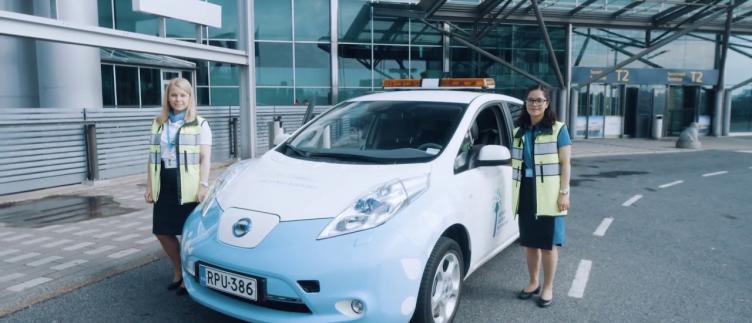Finavia's climate programme is part of our sustainability programme, the three cornerstones of which are the well-being of people, sustainable air traffic, and good governance and finances. Learn more about Finavia’s sustainability programme: Towards sustainable air travel.
Our climate programme started in 2008. At that time, we started calculating our carbon footprint and began our long-term work to reduce emissions. Nine years later, in 2017, Helsinki Airport’s operations were certified as carbon neutral. Lapland airports followed in 2018, and all Finavia airports were carbon neutral by 2019.
Our next goal is to achieve net zero emissions across our entire airport network by the end of 2025. Net zero emissions means that the emissions generated by our operations are reduced to as low a level as is technically and financially possible, i.e. very close to zero. We offset the remaining emissions in projects that use carbon sequestration-based offsetting.
Our net zero target is in line with the International Organization for Standardization’s (ISO) Net Zero Guidelines (IWA 42:2022) and Level 5 of the Airport Carbon Accreditation programme.
Learn more: ISO Net Zero Guidelines and Level 5 of the Airport Carbon Accreditation programme.
The first Finavia airports to achieve net zero emissions in their own operations were Rovaniemi, Kittilä, Ivalo and Kuusamo airports in 2023. Helsinki Airport followed in 2024. Our operations at all 20 of our airports will reach net zero emissions by the end of 2025.
Together with our partners and other actors in the aviation industry, we also aim to reduce emissions from the entire value chain.
Read more about our commitment to reducing carbon emissions in the Finavia Net Zero Carbon Roadmap.
The energy-related carbon dioxide emissions of Finavia’s own operations throughout the airport network in 2012–2024. By the end of 2024, we managed to reduce carbon dioxide emissions by more than 90% compared to 2012.
How have we reduced emissions at our airports?
There are several sources of carbon dioxide emissions at airports. Emissions are mainly from the energy required for the operation and maintenance of airport infrastructure, such as the lighting of aprons and runways, as well as heating, cooling and ventilation of buildings and terminals. Vehicles and maintenance equipment operating at the airport also consume energy.
In addition to energy-related carbon emissions, we also calculate the carbon dioxide emissions from the anti-skid agents used.
We use and have continuously increased the use of renewable energy in our airport network: all the electrical energy we use is CO2-free energy produced with guarantees of origin. We also produce electrical energy at Helsinki Airport’s solar power plant. About 85% of the thermal energy we use is produced from renewable energy sources – the goal is to reach 100% in the near future.
We have been using renewable diesel at all of our airports since 2020. We have switched to using renewable fuel oil in our operations at our Lapland airports and Helsinki Airport. At other airports, we will switch to using renewable fuel oil in 2025.
Our ground equipment runs on renewable diesel and fuel oil, which are produced from waste and leftovers.
We have invested in energy efficiency through, for example, LED technology and automation as well as programmes that encourage and aim for energy efficiency.
At the net zero level, a couple of per cent of emissions still remain. To offset these remaining emissions, we participate in projects that sequester carbon from the atmosphere. These include, for example, afforestation and biochar projects. The offsetting projects that we take part in meet the criteria of the international Airport Carbon Accreditation (ACA) programme.
Airports on the journey towards sustainable air travel
We understand that, as an airport company, we are not able to solve the climate challenges of the entire aviation industry. However, we want to do all we can in the air traffic value chain for more sustainable aviation.
We engage in climate cooperation with the entire value chain and have extended our climate programme to also include other companies operating at our airports. For example, we have worked together with airlines and the air navigation company to shorten airplanes’ taxiing distances and develop the use of airspace in a way that reduces fuel consumption and emissions. Together with ground handling companies, we ensure that the airport’s infrastructure enables the highest possible degree of electrification in ground handling equipment. Low-emission public transport links offer a low-carbon alternative for getting to the airports.
We promote zero-emission aviation and the development of the use of alternative motive power. We have joined Hydrogen Cluster Finland and participate in the Nordic Network for Electric Aviation. We are involved in the BSR HyAirport project, which aims to promote fossil-free air traffic in the Baltic Sea region. We have also taken part in financing the development of Finland’s first electric aircraft in cooperation with the Finnish electric aircraft association Sähkölentokoneyhdistys.
Hydrogen-powered buses may be a viable option for passenger transport on the apron (left). The information gained about electric aircraft helps Finavia prepare for future developments (right).
Finavia participates in international aviation emission commitments
We are a key player in the common goal of Airports Council International Europe, which aims to achieve net zero carbon emissions at all European member airports by 2050. By 2024, more than 300 European airports in 32 countries, representing 80% of Europe's passenger air traffic, were committed to this goal. Of these, 118 airports have set themselves the goal of achieving net zero emissions by 2030 or earlier.
Finavia is also involved in these commitments. Our goal is to achieve net zero emissions in our our operations by the end of 2025.
In addition, the European aviation industry has prepared an updated Destination 2050 roadmap, which presents a pathway towards net zero emissions by 2050, to which Finavia is also committed.
Read more about the emission targets for European airports in the ACI Europe article and the commitment to reach net zero emissions by 2050. You can find more information about the Destination 2050 roadmap here.
